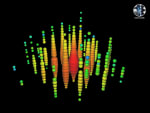It doesn’t snow much at the South Pole but there is lots of snow that accumulates there, and sometimes it needs to be moved. Such was the case last week, when a digging crew was put to the task of removing old field equipment from another South Pole experiment, ARIANNA, a proof of concept for […]
Neutrino astronomy and glaciology meet at IceCube’s Polar Science Workshop
The IceCube Neutrino Observatory has a uniquely close relationship with ice. The telescope needs ice—and a lot of it—to detect the astrophysical neutrinos it was built to study. In fact, most of IceCube’s instruments are embedded in a cubic kilometer of ice at the South Pole. Construction of the detector required drilling 2.5 kilometers straight […]
Week 1 at the Pole
The first full week of the year was a busy one! So much going on… The IceCube detector was well behaved, but there were still several maintenance items to take care of. One of the maintenance tasks involved the IceACT camera on the roof of the ICL, and while they were working, they discovered one […]
Animations
IceCube Collaboration awarded 2021 Rossi Prize
The 2021 Bruno Rossi Prize was awarded to Francis Halzen and the IceCube Collaboration “for the discovery of a high-energy neutrino flux of astrophysical origin.” The Bruno Rossi Prize is awarded annually by the High Energy Astrophysics Division of the American Astronomical Society. The 2021 HEAD awards were announced last night at the 237th AAS Meeting, which is being […]
28 very high energy events, published in Science (November 2013)
This album contains images and videos of the first high-energy neutrino flux ever observed. Flavors, directions, and energies of these neutrinos have been found to be incompatible with those expected from the atmospheric muon and neutrino backgrounds and consistent with generic predictions for an additional component of extraterrestrial origin. Press release (link). […]
Travel to the Pole
Neutrino Events
A compilation of some cool and unique neutrino events captured by the IceCube Neutrino Observatory. […]
Drilling and Deployment
After years of drilling holes and deploying DOMs, the IceCube detector was finished on December 18, 2010. See the process here. […]









